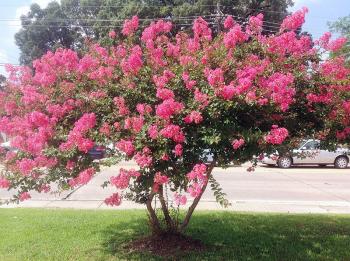
Griffin Weeping Pink crape myrtle is an old variety that’s hard to come by these days.
--Allen Owings photo
Crape myrtles available in all sizes
HAMMOND — More varieties and sizes of crape myrtles are available than many people realize. You can choose from more than 100 varieties with more being added each year. Unfortunately, due to demand, only about 10 to 15 varieties are readily available at garden centers around Louisiana.
Some varieties are great performers in the landscape. They fit smaller landscapes, bloom just as long as the more popular varieties (such as Natchez, Tuscarora and Muskogee) and have disease resistance. But they’re just are not widely known to many home gardeners — and in some cases horticulture industry professionals.
Three great semi-dwarf crape myrtles for consideration are Acoma, Tonto and Sioux. These have smaller mature heights of 12 to 16 feet and are hybrids that were released from the United States National Arboretum.
Acoma is a beautifully shaped variety. The canopy matures to a weeping, umbrella shape on a 12-foot-tall tree. White flowers start appearing in early June in south Louisiana and continue for 70 to 80 days. In LSU AgCenter studies, powdery mildew, a major disease in crape myrtles, has not been significant. The bark of Acoma crape myrtles exfoliates after five to seven years.
Tonto is a semi-dwarf with red flowers. Plants reach 10- to 12-feet tall, although some people have reported heights of 14 to 15 feet. This variety is more upright-growing than Acoma. Disease resistance is also good for this variety.
Sioux produces hot-pink flowers and is probably slower-growing than Acoma or Tonto. It has a stronger upright, tight-growing growth habit and is a superior bloomer. Sioux has excellent resistance to leaf spot and powdery mildew.
A few other hybrid crape myrtles to try that are not as well known include Apalachee, Osage, Yuma and Catawba.
Apalachee is a nice grower with a loose, upright habit. It matures at 20 feet and has soft lavender blooms. Apalachee has good leaf spot resistance and has cinnamon-orange bark as the tree matures.
Osage is a favorite of Southern Living magazine. It’s a 15- to 8-foot grower and has delicate light pink flowers with chestnut brown bark. This variety has done very well in terms of disease resistance in previous LSU AgCenter trials.
Yuma is spectacular in bloom. After 15 years, plants are 15- to 16-feet tall. Lavender blooms appear on top of a wide umbrella canopy.
The main feature of Catawba is the bloom color — deep purple. The trees are smaller growing, typically about 10-feet tall in Louisiana. They are slow growing. Unfortunately, they have disease susceptibility issues, but the deep purple flowers create consumer interest for this plant.
A couple of older, heirloom-type varieties historically important in Louisiana are the hard-to-find varieties Near East and Griffin Pink (also called Griffin Weeping Pink and Griffith Pink).
Many Near East are planted around south Louisiana. Most are 30 to 40 years old, and many are older. The 10-foot tall plants have irregular branching and soft pink flowers.
Griffin Pink has medium to dark pink flowers. This variety originated at Aldridge Nursery in Texas. The plant canopy is lovely, with an umbrella shape possible with proper pruning.
Both of these varieties are not produced by many growers and are becoming harder to locate in the nursery trade.
Consider some of these lesser-known crape myrtles in your landscape. Summer is a great time to observe crape myrtles, look at blooms and pick out your favorites for planting next winter.
You can see more about work being done in landscape horticulture by visiting the LSU AgCenter Hammond Research Station website at www.lsuagcenter.com/hammond.
- Log in to post comments
